Imidacloprid
- CAS NO.:138261-41-3
- Empirical Formula: C9H10ClN5O2
- Molecular Weight: 255.66
- MDL number: MFCD01721131
- EINECS: 428-040-8
- SAFETY DATA SHEET (SDS)
- Update Date: 2025-12-16 16:15:04
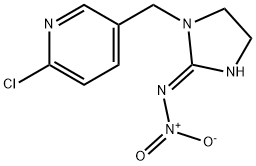
What is Imidacloprid?
Description
Neonicotinoid insecticides were considered safe when they were introduced because their toxicity to mammals is far lower than it is to insects. These compounds act on the central nervous system of insects. Imidacloprid is not only the leading neonicotinoid, but it is the world’s most widely used insecticide. The US Environmental Protection Agency granted the first imidacloprid registration to Miles Laboratories (now Bayer CropScience) in 1994 for use on turfgrass and ornamentals.
In recent years, the declining population of honeybees and other beneficial insects in the United States and Europe has been attributed to the widespread use of imidacloprid. The EPA and other authorities have restricted the use of imidacloprid and other neonicotinoids in areas where bees are known to be active.
Imidacloprid may present another threat. A study by C. A. Hallmann and co-workers at Radboud University in the Netherlands found that?neonicotinoids may be indirectly responsible for the decline in populations of insect-eating birds. The declines began when imidacloprid was introduced in the 1990s.
Chemical properties
Imidacloprid is a white solid crystal or powder under ambient conditions and have a low volatility (U.S. EPA, 2010; HSDB, 2006, 2012b).
History
Imidacloprid was discovered in 1984 at Nihon Bayer Agrochem in Japan by screening novel synthetic compounds for a high affinity to the insect nicotinic AChRs receptors, but with low toxicity to vertebrate species (Kagabu, 1997). Its molecule includes the insecticidal N-(3- pyridinyl)methyl group of nicotine and a nitroimine moiety. Because of their structural similarity to nicotine, imidacloprid and related insecticides (acetamiprid, thiacloprid, thiamethoxam and nitenpyram) were termed neonicotinoids (Tomizawa and Yamamoto, 1993). Nicotine possesses only modest insecticidal activity and is not stable for use in the field for crop protection. Imidacloprid has greater insecticidal activity than nicotine, and its stability is suitable for field use. Both the neonicotinoids and nicotinoids act as agonists at the nAChR. The principal differences between the two classes of compounds are that the nicotinoids are ionized at physiological pH and selective for the mammalian nAChR; whereas the neonicotinoids are not ionized and more selective for the insect nAChR. The selectivity of the neonicotinoids toward insects relative to mammals reflects the fundamental differences in the subunit combination and pharmacological profiles between the nAChR in insects and mammals (for review see Tomizawa and Casida, 2003).
The Uses of Imidacloprid
Imidacloprid is the active ingredient in AdvantageTM used to control fleas in dogs and cats (HSDB, 2006). Clothianidin is the major metabolite of thiamethoxam and both compounds are registered for use as insecticides. Widespread use increased greatly in the 1990s as alternatives to organophosphosphorus and carbamate insecticides because of their much lower mammalian toxicity and resistance developed to other pesticides. Imidacloprid has become the most widespread insecticide used in the world.
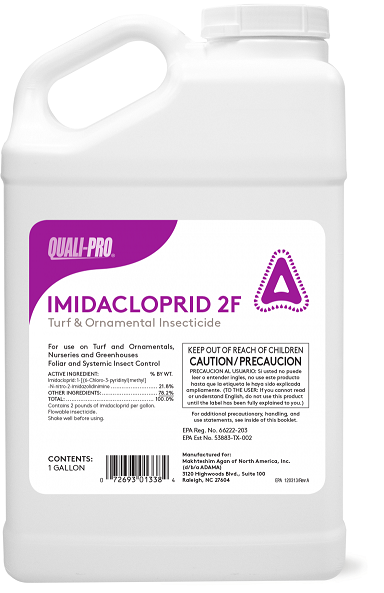
A neonicotinoid; the active ingredient in certain neuro-active insecticides. Reports show that when exposed to neonicotinid pesticides honeybees have probelms returnign home after foraging and bumble bee colonies grow poorly and produce fewer queens.
The Uses of Imidacloprid
The four neonicotinoids are acetamiprid (l),imidacloprid (2), nitenpyram
(3) and thiamethoxam (4) (IS0 draft proposal name). They are potent
broad spectrum insecticides possessing contact, stomach and systemic
activity. The structures are given below and consist of substituted aromatic
heterocyclic rings: 6-chloropyridinyl for acetamiprid, imidacloprid
and nitenpyram and 3-chlorothiazole for thiamethoxam. Each compound
has a methylene bridge, to a cyclic nitroguanidine moiety in imidacloprid
and thiamethoxam, to a cyanoamidine in acetamiprid or to a diaminonitroethylene
group in nitenpyram. The terminal group for all compounds
is a strong electron-withdrawing substituent on an ethene or
imino group.
These insecticides are used for foliar and soil application but imidacloprid
also has a very high usage as a seed treatment. They have low
rates of application: for example thiamethoxam is typically applied to
foliage at rates of only 2.5-50 g ha-1. The neonicotinoids are polar, nonvolatile
solids with high water solubilities and they are non-ionised at pH
values typically found in the environment. The insecticides are not readily
hydrolysed. Their polar nature makes them potentially mobile in soil but
this is mitigated by their low rates of application and, for acetamiprid and
nitenpyram, short persistence. hnidacloprid and thiamethoxam are sufficiently
persistent to be used as soil treaments. All the insecticides are
efficiently translocated in plants and are effective systemic agents against
sucking pests.
What are the applications of Application
Imidacloprid is a neonicotinoid insecticide
Definition
ChEBI: The E-isomer of imidacloprid.
Preparation
Reduction of 2-chloro-5-pyridinecarbonyl
chloride (8) to 2-chloro-5-hydroxymethylpyridine (9) was
carried out by excess NaBH4 in water, which was
converted to the chloride (10) by SOCl2
. Imidacloprid
was obtained by the coupling reaction of 10 with
2-nitroiminoimidazolidine (11) in acetonitrile with potassium
carbonate as base. This method was successfully
applied to the synthesis of [3H]imidacloprid (12)
using NaB[3H]4 as the tritium source (40).
Technical
production starts with the Tschitschibabin reaction of
3-methylpyridine giving 2-amino-5-methylpyridine (14),
which is transformed to the chloride (15) by the Sandmeyer
reaction in the presence of hydrogen chloride. A
successive operation of chlorination of the methyl group to
10 and the subsequent substitution of the active chloride
with ethylene diamine to 16 are carried out without isolation
of the intermediates. The final product is produced by ring formation with nitroguanidine. This multistep process
affords the product at a purity of >95% (41).
Health Hazard
Imidacloprid is rapidly and almost completely absorbed (>92%) from the gastrointestinal tract of rats, and is eliminated from the organism rapidly and completely, with no indication of bioaccumulation of the parent compound or its metabolites (WHO, 2001). Similarly, thiamethoxam has relatively low solubility in nonpolar organic solvents and its octanol/water partition coefficient suggests that accumulation in fatty tissues is unlikely to occur (U.S. EPA, 2010).
Flammability and Explosibility
Not classified
Mechanism of action
Imidacloprid is a neurotoxic insecticide, which belongs to the class of the neonicotinoid pesticides. Imidacloprid is registered to control insect pests on agricultural and nursery crops, structural pests and parasites on companion animals.
Imidacloprid is an agonist of the nicotinic acetylcholine receptor (nAChR) at the neuronal and neuromuscular junctions in insects and vertebrates. It is structurally and functionally related to nicotine. The toxicity of imidacloprid is largely due to interference of the neurotransmission in the nicotinic cholinergic nervous system. Prolonged activation of the nAChR by imidacloprid causes desensitization and blocking of the receptor, and leads to incoordination, tremors, decreased activity, reduced body temperature and death. Presently, there is no specific antidote, which acts as an antagonist to the effects imidacloprid.
Pharmacokinetics
Imidacloprid is quickly absorbed by the oral route and rapidly distributed in nearly all organs and tissues. In rats, the oral absorption was estimated as 92-99%. Imidacloprid degrades to a large number of metabolites formed by multiple pathways. The same, or similar metabolites are found in rats, goats and hens. Based on structural considerations, the following metabolites may be of toxicological significance: 6-chloronicotinic acid, imidazolidine 4- and 5- hydroxy compounds, olefinic imidacloprid, desnitro-imidacloprid and the nitrosoimine compound. Metabolites were excreted primarily in the urine as glutathione and glycine conjugates of mercaptonicotinic acid and hippuric acid. Imidacloprid or its metabolites penetrated the blood-brain barrier. The parent compound and some of its metabolites have been detected in milk, meat of goats and hens, and eggs. Pharmacokinetic studies were not available for a direct determination of the rate of absorption from dermal and inhalation routes.
Pharmacology
Imidacloprid is a nitroguanidine compound and belongs to
the nitromethylene family of chemicals. Themode of action
of imidacloprid involves interference with neurological
transmission in insects by binding to the postsynaptic
nicotinic acetylcholine receptors. Imidacloprid is available
as a spot-on treatment for cats and dogs for flea control,
and, following application, it distributes throughout
the skin within 6 h (Bayer, 1996). It is not absorbed
systemically by the animal, and its adulticidal activity
is by contact with fleas.
Imidacloprid, besides its agricultural use,
is also used for the control of subterranean pests and pet
ectoparasites.
Metabolic pathway
The photolytic degradation of imidacloprid in different conditions yields diversified degradation products as indicated in the pathways. Photolysis in water gives 6- chloronicotinaldehyde, N-methylnicotinic acid amide, 1- (6-chloro-3-pyridinyl)methyl-2-imidazolinone and 6-chloro-3-pyridylmethylethylenediamine which are identified as main degradates together with a complex mixture of degradation products. On the surface of the tomato plant, four of the 14 metabolites are identified. In tobacco smoke, five degradates are detected, and in field soils, four metabolites are identified from the treated sugarbeet. As for the mammalian metabolites, the pathways are drawn tentatively by the author (see Klein145).
Metabolism
Acute oral LD50 for rats: ca. 450 mg/kg
Degradation
The hydrolysis of imidacloprid was investigated to US EPA guidelines.
[14C]Imidaclopridw as added to sterile aqueous buffer solutions at pH 5,7
and 9 and incubated at 25 °C in the dark for up to 30 days. Analysis was
by HPLC and TLC methods. No products of hydrolysis were found at pH
5 or 7. Some imidacloprid (7%) degraded at pH 9 (DT50 355 days) and two
products were detected. The major product was not identified but may
have resulted from a small transformation of the imidazole ring. The
minor product was the cyclic urea (2) as shown in Scheme 1.
The photodegradation of imidacloprid in aqueous buffer at pH 7 was
investigated to US EPA guidelines. The UV spectrum of imidacloprid
has a maximum at 269 nm. Solutions were irradiated with a xenon lamp
(8.9-9.5 μW cm-2) for up to 2 hours at 23-24.5 °C. Samples were analysed
by TLC, HPLC and MS. Control samples were protected from irradiation.
The DT50 for photolysis of imidacloprid was 57 minutes. No volatile
products were produced but a large number of photoproducts were
formed. A further study was done using a high initial concentration of
imidacloprid so that photoproducts could be identified. Nine products
were identified as shown in Scheme 1. The five major products were the
cyclic guanidine derivative (3), the cyclic urea (2), an olefinic cyclic
guanidine (4) and the fused ring products (5) and (6). These products
together accounted for 48% of the applied radiocarbon after 2 hours of
irradiation, when 23% of the applied imidacloprid remained. The
proposed routes of aqueous photolysis were via loss of the nitro group
followed by oxidation and piecemeal degradation of the imidazoline
ring affording the minor products 7,8,9,10 and 11 as shown in Scheme 1(PSD, 1993).
Toxicity evaluation
Acute toxicity of imidacloprid was examined via the oral route in rats and mice, and via the inhalation and dermal routes in rats. Mice appeared to be more sensitive to the acute oral toxicity of imidacloprid than rats. In mice, the median oral lethal doses (LD50) ranged between 131-168 mg/kg (Category II oral toxicant). Imidacloprid was classified as Category III dermal toxicant, Category IV inhalation toxicant and Category IV eye and skin irritant. An acute (single dose) oral exposure of rats and mice to imidacloprid caused clinical signs characteristic for nicotine intoxication, such as incoordination, tremors, spasms and respiratory difficulties. Other symptoms included decreased motility and lethargy. The same clinical signs were observed in rats following a 4-hour exposure to imidacloprid via the inhalation route.
Properties of Imidacloprid
| Melting point: | 144°C |
| Boiling point: | 93.5°C (rough estimate) |
| Density | 1.54 |
| vapor pressure | 2 x 10-7 |
| refractive index | 1.5790 (estimate) |
| Flash point: | 2 °C |
| storage temp. | 0-6°C
|
| solubility | DMSO:75.5(Max Conc. mg/mL);295.31(Max Conc. mM) Ethanol:2.0(Max Conc. mg/mL);7.82(Max Conc. mM) Water:1.0(Max Conc. mg/mL);3.91(Max Conc. mM) |
| pka | 7.16±0.20(Predicted) |
| form | Solid |
| form | neat |
| color | White to off-white |
| Water Solubility | 0.061 g/100mL at 20 ºC |
| CAS DataBase Reference | 138261-41-3(CAS DataBase Reference) |
| EPA Substance Registry System | Imidacloprid (138261-41-3) |
Safety information for Imidacloprid
| Signal word | Warning |
| Pictogram(s) |
 Exclamation Mark Irritant GHS07  Environment GHS09 |
| GHS Hazard Statements |
H302:Acute toxicity,oral H410:Hazardous to the aquatic environment, long-term hazard |
| Precautionary Statement Codes |
P273:Avoid release to the environment. |
Computed Descriptors for Imidacloprid
New Products
Indole Methyl Resin tert-butyl 9-methoxy-3-azaspiro[5.5]undecane-3-carboxylate Boc-His(Boc)-OH 2-CTC Resin 4-Chloro-7-tosy1-7Hpyrrolo[2,3-d]pyrimidine 5,7-Dibromo-1H-indole 2,5-dichloro-N-hydroxy-4,6-dimethylpyridine-3-carboximidamide 2,2-Dimethoxy-7-azaspiro[3.5]nonane hydrochloride 4-chloromethyl-5-methyl-1,3-dioxol-2-one (DMDO-Cl) R-2-BENZYLOXY PROPIONIC ACID 1,1’-CARBONYLDIIMIDAZOLE 1,1’-CARBONYLDI (1,2-4 TRIAZOLE) N-METHYL INDAZOLE-3-CARBOXYLIC ACID 4-((2-hydroxyethyl)thio)benzoic acid 1-(TERT-BUTOXYCARBONYL)-2-PYRROLIDINONE Methyl 6-methylnicotinate 3-Pyridineacrylic acid tert-Butyl carbazate TETRAHYDRO-2H-PYRAN-3-OL 2-((4-morpholinophenylamino) (methylthio) methylene) malononitrile 3-(4-morpholinophenylamino)-5-amino-1H-pyrazole-4-carbonitrile 2,4-dihydroxybenzaldehyde 1,3-Diethyl-1,3-Diphenylurea Methyl 2-methylquinoline-6-carboxylateRelated products of tetrahydrofuran
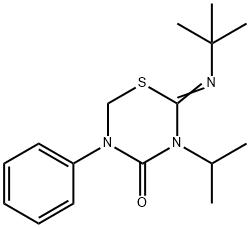
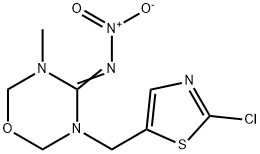
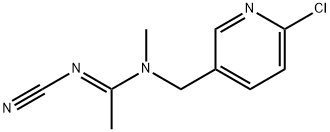


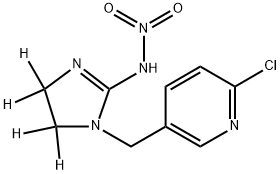


You may like
-
 138261-41-3 98%View Details
138261-41-3 98%View Details
138261-41-3 -
 Imidacloprid 99%View Details
Imidacloprid 99%View Details
138261-41-3 -
 Imidacloprid 138261-41-3 98%View Details
Imidacloprid 138261-41-3 98%View Details
138261-41-3 -
 138261-41-3 98%View Details
138261-41-3 98%View Details
138261-41-3 -
 Imidacloprid 98%View Details
Imidacloprid 98%View Details
138261-41-3 -
 Imidacloprid 95% CAS 138261-41-3View Details
Imidacloprid 95% CAS 138261-41-3View Details
138261-41-3 -
 Imidacloprid CAS 138261-41-3View Details
Imidacloprid CAS 138261-41-3View Details
138261-41-3 -
 Imidacloprid CAS 138261-41-3View Details
Imidacloprid CAS 138261-41-3View Details
138261-41-3
